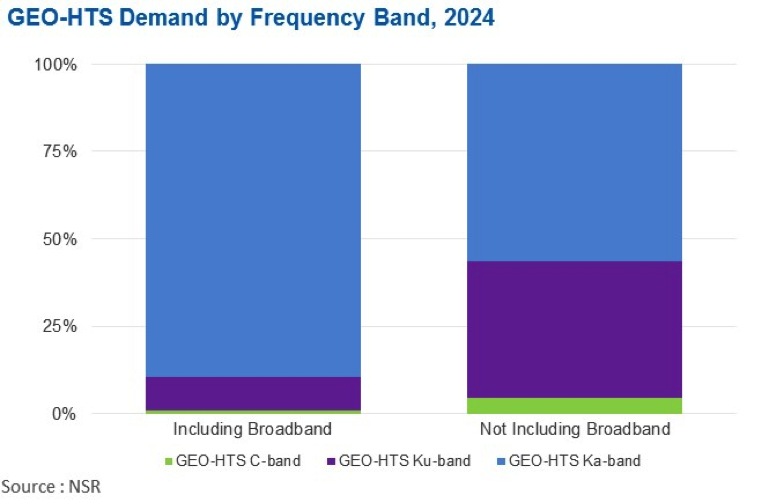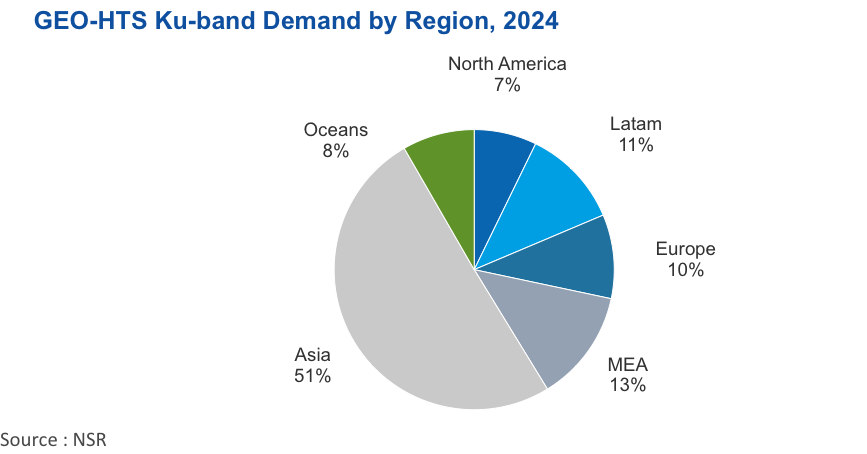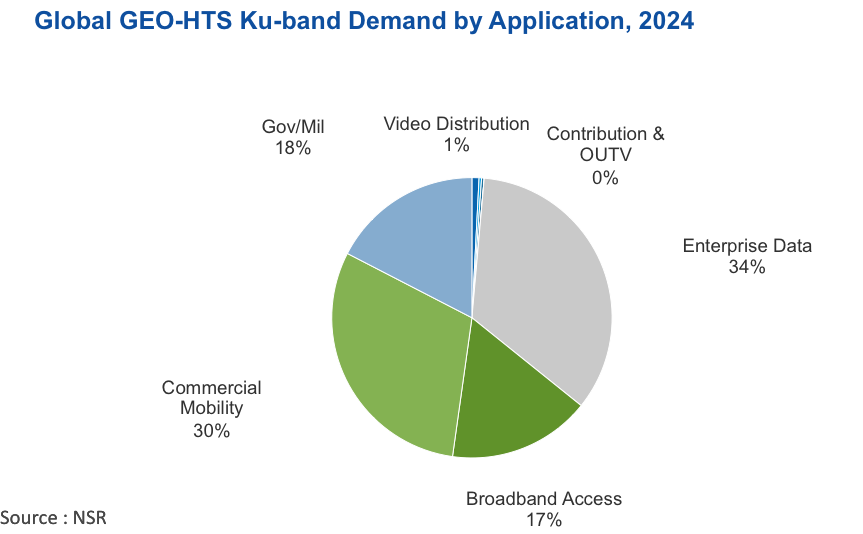Spotting Opportunities Outside Spot Beams
Aug 5th, 2015 by
Blaine Curcio, NSR
High Throughput Satellite (HTS) systems have undeniably
transformed the satellite telecommunications industry, with new
markets opened, new verticals developed, and new players
entering the scene. With this year’s Global Satellite Capacity
Supply & Demand, 12th Edition, (GSCSD12) NSR has for
the first time broken GEO-HTS supply and demand into frequency
bands—in addition to regions and applications—with these new
breakouts revealing interesting new insights about the ways that
the GEO-HTS market will develop, and in particular Ku-band.
GEO-HTS—The Market Today
IPSTAR and Ciel-2 were the first to launch Ku-band HTS, and
while the latter was immediately fully leased for DTH services,
the former has taken time to build up its revenue contribution.
Going forward, Intelsat’s EpicNG fleet, and SES’s trio of
SES-12, SES-14 and SES-15 will be the big contributors of
Ku-band GEO-HTS capacity. The status of Ku-band as the “Video
Workhorse” combined with the relatively more difficult business
models of selling HTS capacity to data businesses, have thus far
prevented operators from investing in Ku-band HTS capacity. The
broader trends at play are an exponential Over-The-Top (OTT)
video demand, flattening of Linear TV viewership and the
acceptance of HTS as the “Data Workhorse”.
A few years in, NSR expects that those that have the spectrum
resources will opt for Ku-band HTS just as easily as today’s Ka-band
HTS launches. At that juncture, applications other than
broadband access will begin to make a significant impact to HTS
business planning decisions.
GEO-HTS—The Market Tomorrow
While broadband justifiably gets a lot of headlines as the
bread and butter for GEO-HTS payloads, and while this will
indeed largely be the case for GEO-HTS Ka-band capacity, it
should be considered that there will be a very real market
developing for HTS Ku-band, which is dominated by higher-value
applications such as Commercial Mobility, Gov/Mil, and
Enterprise Data.

Overall, by 2024, NSR expects over 1.5 Tbps of
GEO-HTS demand, with around 1/10 of this bandwidth
demand coming from Ku-band HTS. That said, Ku-band HTS will have
a much larger percentage of non-broadband demand, with
around 39% of the 325 Gbps of “non-Broadband HTS demand” by 2024
coming from Ku-band HTS. This is expected to total over
$1 billion in leasing revenues by 2024, or more than 25%
of total GEO-HTS leasing revenues. All said, the
Ku-band GEO-HTS market will total 150 Gbps of demand, spread
fairly evenly across several high value applications, including
Enterprise Data, Commercial Mobility, and Gov/Mil. The
opportunities in Enterprise Data—the largest vertical for
Ku-band GEO-HTS—will include nearly 30 Gbps of demand
coming from Trunking and Backhaul.
Beyond this, a large portion of GEO-HTS Ku-band demand will
come from Commercial Mobility, with a significant percentage of
demand coming from aeronautical, due to the suitability of
GEO-HTS widebeam Ku-band beams. Overall, these higher-value
applications will present a solid market for the right GEO-HTS
Ku-band offerings, with a number of major players having already
announced considerable investment into HTS Ku-band to target
these key growth applications.
Regional hot spots include Asia-Pacific, where Ku-band
GEO-HTS has significant legacy through Thaicom’s IPSTAR, as well
as the Middle East & North Africa, which is expected to see
offerings enter the market in the coming years from players such
as SES, Intelsat, and even ISRO with GSAT 11. For example, by
2024 it is expected that over 50% of GEO-HTS Ku-band
demand will come from Asia, with the region currently
leading the world in GEO-HTS Ku-band adoption.


Bottom Line
With this the first year in which NSR segmented GEO-HTS
capacity into frequency bands, a number of interesting trends
have emerged that have given us a new lens through which to look
at the way that the GEO-HTS market is evolving. While spot beam
Ka-band coverage tends to steal the headlines, there remains
a significant market for Ku-band GEO-HTS services,
with over $1 billion in revenues and over 150 Gbps in demand by
2024. Beyond that, these services tend to be more
specialized—for instance, a commercial airliner flying at 500Mph
could not practically use a <100 mile-wide spot beam—and as
such, there may be a premium paid moving forward for Ku-band
GEO-HTS capacity. All said, the 150 Gbps of demand coming for
Ku-band GEO-HTS will be concentrated in higher-value
applications, and will indeed pose a significant market
moving forward.